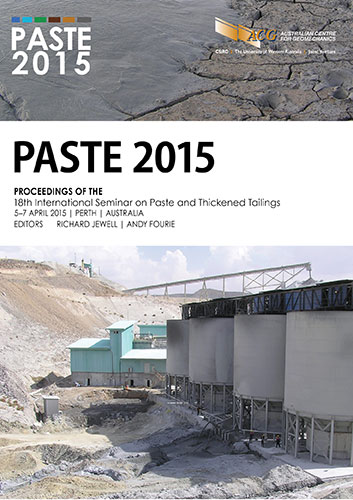Upstream stacking of thickened tailings at Neves Corvo

|
Authors: Lopes, R; Bahia, R; Jefferies, M; Oliveira, M |
DOI https://doi.org/10.36487/ACG_rep/1504_40_Lopes
Cite As:
Lopes, R, Bahia, R, Jefferies, M & Oliveira, M 2015, 'Upstream stacking of thickened tailings at Neves Corvo', in R Jewell & AB Fourie (eds), Paste 2015: Proceedings of the 18th International Seminar on Paste and Thickened Tailings, Australian Centre for Geomechanics, Perth, pp. 521-534, https://doi.org/10.36487/ACG_rep/1504_40_Lopes
Abstract:
Neves Corvo is a world-class underground copper–zinc mine located in the south of Portugal. The mine has been operating since 1988 by Somincor (Sociedade Mineira de Neves-Corvo SA), a wholly-owned subsidiary of Lundin Mining Corporation from Canada. The pyritic tailings produced has a very high acid generation potential and until 2010 had been placed subaqueously in the Barragem Cerro do Lobo (BCL), a large tailings pond (190 ha) created by a rockfill dam, 42 m high, across a natural water course. In late 2010 Somincor switched to using subaerial paste/thickened tailings deposition over the existing subaqueous slurry deposit. This approach accommodates the required 17.4 Mt storage capacity from 1 January 2010, as per Somincor’s 2005 life-of-mine (LOM) plan, and allows maintaining the existing perimeter embankment at its current elevation and facilitates site closure (Lopes et al. 2013). The results of the first two years of operation of the paste production plant and depositional performance of the first 2 to 4 m of paste/thickened tailings over the very loose subaqueous deposit, were presented at Paste 2013 in Brazil (Lopes et al. 2013). Somincor’s 2014 LOM studies have established additional reserves and related demand for additional tailings and mine waste rock storage at the Neves Corvo tailings storage facility (TSF) beyond the 2005 deposition design. Specifically an increase of up to 27 Mt of tailings and as much as 10 Mt of mine waste rock need to be accommodated into an expanded Neves Corvo TSF, relative to the 2005 design. Following an evaluation of alternatives for expansion of the TSF, upstream stacking of thickened tailings at an overall slope of 4 to 6% is the selected solution. The upstream stacking solution decouples the desired stacking slope from the beach slope variability inherent to the operation at this site (Lopes et al. 2013). A critical aspect of this design approach is that the rate of rise of the stack cannot exceed the rate of strength gain of the thickened tailings and underlying subaqueous tailings. This is assured by continuous monitoring of tailings pore pressure at piezometer installations and by periodic CPTU testing of the deposit. In addition, laboratory testing of settling, drying and consolidation behaviour of the thickened tailings was performed to assist in the interpretation of the observed field data and to forecast stability of the proposed final landform. Some operational changes have been made to the previous deposition into cells from a single point of discharge. An array of perimeter spigots is now used to assure a wider spreading of the tailings over the operating area and promote faster drying and strength gain. In addition the frequent cycling of discharge spigot locations and the final cover design will assure a high level of saturation of the raised landform, in order to control acid generation and metal mobilisation.
References:
Been, K & Jefferies, MG 1985, ‘A state parameter for sand’, Geotechnique, vol. 35, pp. 99-112.
Junqueira, F, Wilson, G & Oliveira, M 2009, ‘Surface paste disposal of high-sulphide tailings at Neves Corvo Mine in Portugal, part 1: estimation of tailings desaturation and implications on ARG generation’, Proceedings of the 8th International Conference on Acid Rock Drainage (ICARD) and Security, the Future: Mining, Metals and the Environment in a Sustainable Society 2009, vol. 1, Curran Associates, Inc., Red Hook.
Lopes, R, Bahia, R, Jefferies, M & Oliveira, M 2013, ‘Paste deposition over an existing subaqueous slurry deposit of high sulphide content tailings – the Neves Corvo experience’, in RJ Jewell, AB Fourie, J Caldwell & J Pimenta, Proceedings of the 16th International Seminar on Paste and Thickened Tailings, Australian Centre for Geomechanics, Perth, pp. 21-35.
Oliveira, M, Falé, P & Rodrigues, A 2011, ‘Surface paste disposal of high-sulphite tailings part 1 – construction of cells’, in A Ofset (ed), Proceedings of the 22nd World Mining Congress and Expo 2011, vol. 2.
Salfate, ER 2011, ‘Predicting void ratio for surface paste tailings deposited in thin layers’, MSc thesis, University of British Columbia.
Verburg, R, Ross, C & Oliveira, M 2009, ‘Surface paste disposal of high-sulphite tailings at Neves Corvo Mine in Portugal, part 2: field trial cover performance monitoring and impact assessment’, Proceedings of the 8th International Conference on Acid Rock Drainage (ICARD) and Security, the Future: Mining, Metals and the Environment in a Sustainable Society 2009, vol. 1, Curran Associates, Inc., Red Hook.
© Copyright 2025, Australian Centre for Geomechanics (ACG), The University of Western Australia. All rights reserved.
View copyright/legal information
Please direct any queries or error reports to repository-acg@uwa.edu.au
View copyright/legal information
Please direct any queries or error reports to repository-acg@uwa.edu.au